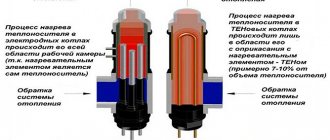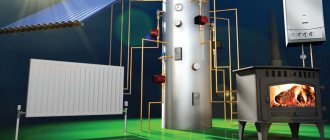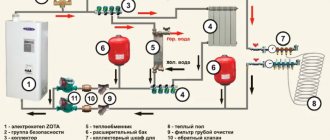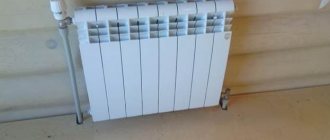This table provides information on the monthly electricity consumption of electrical household appliances.
| Electricity consumer | Power, kWt | Qty | Average operating time | electricity consumption (kWh) |
| Fridge | 1 | 1 | 2 hours a day (including pauses) | 60 |
| Kettle | 2 | 1 | 0.3 hours a day | 18 |
| TV | 0,1 | 1 | 5 hours a day | 12 |
| Washing machine | 1,5 | 1 | 3 hours a week | 20 |
| Iron | 1,2 | 1 | 1 hour per week | 6 |
| Microwave | 1,2 | 1 | 15 min.day | 9 |
| Vacuum cleaner | 1,2 | 1 | 30 min. week | 3 |
| Lighting lamps | 0,06 | 10 | 3 hours a day | 54 |
| Convector (heater) | 1 | 1 | 4 hours a day (including pauses) | 120 |
| Water supply pump | 1,5 | 1 | with an average switching on of 40 days for 10 seconds. | 5 |
| Computer | 0,16 | 1 | 1 hour | 5 |
| TOTAL | 312 |
These data are based on the residence of an average family of 3 people. Also, please note that the number of appliances listed in the house is often used more. Sometimes, in a country house there are 2-3 refrigerators, dishwashers are used, there may be more than 1 heater, an electric stove, etc. not to mention houses that are heated entirely by electricity. We also have bathhouses, gazebos, watering pumps, site lighting and much more. So, once again, when you pay for the consumed electricity per month at 60 - 100 kWh, doesn’t this mean that you either use only a refrigerator, or use solar panels and wind energy generators.
Electricity consumption of household appliances: table and tips for saving
The annual increase in the cost of electrical energy forces users to think about methods of controlling its consumption and ways to save. The instructions for any equipment indicate the power of the device. However, this is an average value and may vary depending on certain factors. You can learn how to correctly calculate the electricity consumption of household appliances from this article.
The more appliances you use in your home, the higher your energy costs will be.
How to increase allocated power
The power of electricity in an apartment or private house can be increased based on new technical conditions. The document is valid for 2 years. It states:
- new permitted power indicators;
- voltage parameters – 380 or 220 V;
- environmental standards;
- ways to control the consumption and conservation of electricity.
Features of treatment for individuals and legal organizations vary.
For individuals
Fragment of a standard act of delineation of book value
Additional power must be installed in stages:
- Collection of documents - a certificate or agreement on real estate ownership, a certificate with current power parameters, an agreement with an energy supplier, an act of shared operational responsibility.
- Implementation of a building electrification scheme.
- Agreeing with the provider company on the possibility of increasing power.
- Signing of the project at Energonadzor.
- Inspection – The power plant is inspected and tested.
- Drawing up a report and approval for increasing the power load. The first document is prepared by an employee of the energy company, the second by a representative of Energonadzor.
All documents are sent to the supplier company, which makes the final decision.
For legal entities and companies
The sequence of the procedure is similar to the algorithm for private users. Only the documents differ. An ordinary citizen presents a passport, and a legal entity presents constituent papers. They are certified with a wet round seal and the signature of an authorized person.
If the technical connection papers do not contain information about the maximum power parameters or they were lost, the network enterprise has the right to re-register. It is implemented on the basis of a consumer application in the form established by the organization. The electricity supplier, according to Regulation No. 861, should not expand the list of documents and request additional data.
Total power in W: how much energy do household appliances consume in kW
Any apartment is equipped with the necessary set of household appliances and electrical equipment. Each type of equipment has individual technical characteristics, including power and energy consumption. The total value of all these factors determines the total amount of electrical energy consumed, which will be different for each family.
Distribution of energy consumption by electrical appliances as a percentage.
In order to plan possible expenses, some owners resort to compiling a table of electricity consumption by household appliances per hour, where they indicate the name of the consumer, its power and duration of operation throughout the day. Information about the total energy consumption of household appliances and lighting elements is necessary for installing switching and protective equipment and selecting the cross-section of electrical wiring.
On a note! To determine the total power, the corresponding consumer values must be converted into one unit of measurement, so it is important to know how many W are in 1 kW.
From the table below you can conclude which household appliances consume more electricity. These include a lighting system, refrigerator, TV, computer, washing machine, electric kettle and iron. The total value averages 120-180 kW per month. Additional costs include the use of small household appliances in the form of a hair dryer, coffee maker, food processor, chargers and other elements that provide the required level of comfort. In the summer, the use of air conditioning is also taken into account, and in winter - oil electric heaters, which add 60-100 kW.
Energy consumption table for household appliances
For each home, the number of electrical devices, the value of their electricity consumption and the duration of operation will be different. The table below for energy consumption of household appliances contains average information:
| Device name | power, kWt | Operating time per day, h | Consumption per day, kWh | Consumption per month, kWh |
| Fridge | 0,15-0,6 | 24 | 3,6-8,6 | 10,8-25,8 |
| Lighting (10 lamps 20 W each) | 0,020 | 5 | 0,1 | 3 |
| Washing machine | 1-2,2 | 1 | 1-2,2 | 20-30 |
| Vacuum cleaner | 0,65-2,2 | 15 minutes | 0,16-0,55 | 1,6-5,5 |
| TV | 0,1-0,3 | 5 | 0,5-1,5 | 15-30 |
| Microwave | 1,5 | 30 minutes | 0,75 | 10-15 |
| Electric kettle | 0,7-3 | 15 minutes | 0,25-0,75 | 7,5-16,5 |
| Computer | 0,1-0,2 | 5 | 0,5-1 | 7-20 |
| Iron | 1,1 | 15 | 0,3 | 5-8 |
| Dishwasher | 0,5-2,8 | 1 | 0,5-2,8 | 7,5-15 |
| Multicooker | 0,2-2,4 | 1 | 0,2-2,4 | 2-24 |
| Food processor | 0,2-2,0 | 15 minutes | 0,05-0,5 | 0,5-3 |
| Air conditioner | 0,7-1,3 | 7 | 3,5-8 | 15-35 |
| Hairdryer | 1,2-1,5 | 15 minutes | 0,3-0,4 | 5-7 |
| Heater | 1,5 | 5 | 7,5 | 75 |
| Electric stove | 2-8,5 | 3 | 5-10 | 30-150 |
| Coffee maker | 1,5-3,5 | 15 minutes | 0,3-0,8 | 5-10 |
| Hood | 0,1-0,5 | 3 | 0,3-1,5 | 3-4,5 |
Refrigerator: how many watts does it consume per hour?
When answering the question of which electrical appliances consume the most energy, the refrigerator will be first on the list. This device works around the clock. The actual energy consumption of the refrigerator is calculated taking into account the international classification of energy efficiency devices. This parameter is designated by a letter with a certain number of pluses; the more there are, the lower the level of electricity use.
The classification of a household appliance by energy efficiency is as follows:
- A++ - the highest class with maximum energy saving. Electricity consumption is 30% of the standard value;
- A+ - energy consumption - 30-42% of the standard;
- A - energy consumption - 42-55% of the standard;
- B - energy consumption - 55-75% of the standard;
- C – energy consumption – 75-90% of the standard;
- D – energy consumption – 90-100% of the standard;
- E - energy consumption - 100-110% of the standard;
- F - energy consumption - 110-125% of the standard.
However, the energy efficiency parameter is very average. Since the amount of electricity consumed by the refrigerator is affected by its operating mode, workload, and the number of door openings.
The refrigerator consumes the most energy of any electrical appliance.
On a note! The instructions for the refrigerator indicate the energy efficiency class and the amount of electricity it consumes per hour.
Annual energy consumption corresponds to 220-460 kW. It is impossible to obtain an accurate result for a table of electricity consumption per day or month by simply dividing this value. Since energy consumption is influenced by a number of factors, such as freezing power, ambient temperature, and product filling level.
To reduce the energy consumption of the refrigerator, it is necessary to operate the device correctly, do not leave the internal space empty when it is turned on, do not open the door for a long time, do not put hot food in, check the condition of the seals, ensure that there is a gap between the refrigerator and the wall, regularly defrost, wash and dry the unit.
Calculation of electricity for a disabled person and his family
The situation is even more confusing with people with disabilities and socially vulnerable groups of the population, for whom discounts on electricity payments are established. First of all, before calculating electricity for a disabled person, you will need to register the right to benefits at the local social security department based on the following documents:
- A written application for benefits indicating the personal account number for payment of electricity;
- Photocopies of the passport and the original certificate of disability;
- Information about family composition.
For your information! There will be no benefits if at the time of application there is arrears on utility bills.
In 2022, the state provided benefits in the consumption of electrical energy for families of disabled people at a rate of 45 kWh and 70 kWh for a gas burner and electric stove, respectively. For single disabled people, the preferential rate is 50 kWh and 80 kWh. These volumes are paid at half the current tariff. Anything that exceeds the preferential volume must be calculated at the full tariff rate.
In the future, it is planned to provide subsidies, benefits and social norms for electricity only to households equipped with appliances of a consumption class of at least “B”. If you calculate the energy consumption after replacing conventional incandescent lamps with LED ones, you can be sure that the savings are at least 20% only on the internal and external lighting of the house.
How to calculate your TV's electricity consumption
A TV is an essential element of household appliances in every home. Often, owners install several copies for each room. Devices can be of several types: cathode ray tube models, LED, LSD or plasma TVs. The power consumption of a device is affected by its type, screen size, color, brightness, white and black balance, active operation time, and duration of sleep mode. Based on the table of electricity consumption by household appliances, a TV uses an average of 0.1-0.3 kW.
Electrical energy consumption will depend on the type and operating mode of the TV.
The power of TVs in Watts with a cathode ray tube is 60-100 W per hour. On average he can work about 5 hours a day. Monthly consumption reaches 15 kW. This is how much electricity will be spent on its active operation. The TV also consumes 2-3 watts per hour in standby mode when plugged in. Total energy consumption can be 16.5-17.5 kW per month.
The energy consumption of LED or LSD models directly depends on the screen size. For example, an LSD TV with a 32-inch screen diagonal will consume 45-55 W per hour in operating mode, and 1 W in standby mode. The total electricity consumption per month is 6.7-9 kW. LED models consume on average 35-40% less electrical energy. In active mode, a 42-inch TV will use 80-100 W, in sleep mode - 0.3 W. Total consumption per month will be 15-20 kW.
Plasma TVs have good color reproduction. The TV power in kW is 0.15-0.19 in active mode, and 120 W/day in sleep mode. The total consumption per month can be 30-35 kW. To save energy, you should remove the plug from the socket, correctly adjust the brightness level depending on the time of day, and set the timer to automatically turn off.
How to determine what the allocated electricity capacity is in your home?
There are several ways to determine the exact allocated power that a private house or summer cottage has.
1) View the rating of the input machine
The easiest way to determine the allocated power of electricity to a house is by the value of the operating current for which the input circuit breaker installed in the electrical panel is designed. To do this you will need to perform a simple calculation. For example, on the body of the input machine the operating current is indicated as 32 A. It is necessary to use the following formula: P max = U x I, where:
- U – rated mains voltage (220 or 230 V – will depend on what mains voltage is supplied to the house);
I – indicator of the operating current of the input circuit breaker in amperes.
The problem with this method is that the rating of the input machine does not always coincide with the official allocated power.
For example, this occurs when an external line has been upgraded with an increase in its power, and also if the electrical wiring has not been changed for a long time or its installation was performed poorly.
If the allocated power of electricity significantly exceeds the capabilities of the input circuit breaker, then it would be advisable to replace it and bring all electrical wiring in the house into compliance.
2) Contact the operating organization
The allocated power per home can also be found in the electricity supply contract. If it is missing, then you must contact the operating organization, which must issue a certificate of actual power consumption and installed power. In Moscow and the Moscow region, this is done by Mosenergosbyt OJSC. The company provides the service for a fee, its cost is on average 2 thousand rubles.
If a private house is serviced by a management company, then it is the company that is obliged to issue the owner a certificate of allocated power or permission to connect to the house’s electrical networks and an act of delimitation of balance sheet ownership and operational responsibility.
In SNT, the data on allocated power for each site is owned by the chairman of the partnership, who must inform its users about this.
3) Study the energy supply agreement
You can find out the allocated power in the contract for power supply of an individual residential building (household) between Mosenergosbyt OJSC and the owner. Information about this is usually indicated in the “Subject of the Agreement” section with the following wording: the maximum power of a household is determined based on the parameters of the technological connection of the subscriber’s power receiving devices to electrical networks and is 5 kW.
Washing machine operation: how many kilowatts does the device consume?
To calculate how many watts a washing machine spends on one wash cycle follows from the calculation of its brand, model and technical characteristics. Energy is spent on the operation of the electric motor, which can be in the range of 400-800 W, heating element - 2 kW, pump for draining water - 40 W, control system in standby mode - 3-10 W. This indicator directly depends on power consumption.
The higher the temperature the washing mode provides, the higher the energy consumption will be.
The washing mode also affects the total consumption. The lower the water temperature, device operating time and speed, the less electricity the machine will consume. Washing machines have an energy consumption class, which determines the required amount of electricity:
- class A+ - energy consumption 0.17 kWh;
- class A – 0.17-0.19 kWh;
- class B – 0.19-0.23 kWh;
- class C – 0.23-0.27 kWh;
- class D – 0.27-0.31 kWh;
- class E – 0.31-0.35 kWh;
- class F – 0.35-0.39 kWh;
- class G – more than 0.39 kWh.
Based on the class, model, mode, load and water temperature, the machine consumes 300-1600 Wh per washing cycle.
In order to reduce the amount of electricity consumed, it is necessary to choose the optimal mode, which will depend on the degree of soiling of the laundry and its composition. A significant part of the electricity is spent on heating water and spinning. The machine should be fully loaded, since the units cannot determine the relationship between the amount of laundry and the value of electricity consumption per cycle. The machine should be cleaned at least once every six months using special products.
Many washing machine models have water and energy saving modes.
Standards
According to the standards, the following resource consumption figures are given for one person living in housing:
- In Moscow, if you have a gas stove, the norm is 50 kilowatt-hours. If it is not there, the number increases to 80.
- In St. Petersburg these figures are 78 and 111, respectively.
- In Chelyabinsk 100 and 180.
These values are established exclusively in each region and are regulated by local governments. They are necessary in order to reduce household expenses and increase the responsibility of management companies. The indicated figures will calculate the amount that is necessary to satisfy the minimum needs of a person. Naturally, non-contractual electricity consumption is unprofitable, first of all, for the consumer himself.
Sometimes they install devices that take into account general household consumption, but it is still more convenient to plan electricity consumption with a personal meter. As for unauthorized selection, this action will entail criminal liability.
Electricity consumption of an electric stove
Electric stoves are very popular among consumers. The amount of electricity consumed by a device is affected by the type of hob, which can be induction or heating element, the diameter of the burners, the power and functionality of the device.
On a note! An induction surface consumes less electricity compared to an electric one.
The power of a household appliance directly depends on the number of burners and their diameter, which can be 14.5; 18 and 20. Accordingly, energy consumption is 1; 1.5 and 2 kW.
The oven power corresponds to 1.8-4 kW. The minimum energy consumption with one operating burner is 1 kW. The maximum power of an electric stove is calculated taking into account the number of simultaneously operating burners and the operating mode of the oven. It can be 5-8.5 kW, as can be seen from the table of the power of household appliances and their energy consumption.
To save energy when operating an electric stove, you should follow some recommendations:
- it is necessary to choose the correct diameter of the pan for a specific burner;
- It is better to use dishes with a flat bottom;
- To save heat loss, the pan should be covered with a lid.
By following simple cooking rules, you can save energy consumption on your electric stove.
The allocated power for the apartment is unknown, how can I find out?
Method 1. View the nominal value of the installed machine near the meter (not the most accurate method)
See what circuit breakers (circuit breakers) are located near the meter. Based on the rating of the machine, you can determine the allocated power and the number of phases.
For example, if we see a single-pole or two-pole circuit breaker, it means there is only one phase. The numbers will tell you the allocated power:
Two-pole circuit breaker with a rating of 32 amperes
- C16 - means 16 amperes, multiply 16A by 230 volts, we get 3680 watts, total 3.6 kilowatts. Typically, such power was allocated in apartments of the 50s, equipped with a gas stove.
- C25 - means 25 amps, multiply 25A by 230 volts, we get 5750 watts, total 5.7 kilowatts.
- C32 - means 32 amps, multiply 32A by 230 volts, we get 7360 watts, total 7.3 kilowatts.
- C50 means 50 amps, multiply 50A by 230 volts, we get 11,500 watts, total 11.5 kilowatts.
- C63 - means 63 amps, multiply 63A by 230 volts, we get 14490 watts, total 14.5 kilowatts.
If the circuit breaker is three or four pole, then the network is three-phase , then you can safely multiply the value calculated above for a single-phase network by 3.
Three-pole circuit breaker with a rating of 25 amperes
For example, a three-phase C25 circuit breaker will withstand a power of 17.1 kilowatts, but this is the maximum power, not the allocated power, and usually for a C25 circuit breaker the allocated power is exactly 15 kilowatts .
As you can see, determining the allocated power using a circuit breaker is not the most accurate method .
Then how to find out the exact number? Agreement with energy sales?
Method 2. View the power specified in the electricity supply contract.
What is an electricity supply agreement?
An electricity supply agreement is a formal agreement with an energy retailer , under which the electricity supply company undertakes to provide electricity to the consumer.
What to do if you don’t have a power supply contract in your hands?
You must contact Energy Sales (the company responsible for providing electricity) at your address and request this agreement.
Sample energy supply agreement
How much does an electric boiler consume?
Electric boilers are installed in houses for heating and water heating. However, the simplicity of the design and ease of operation hides high energy consumption. Models of electric boilers differ in power, design, number of circuits and method of heating the coolant (heating elements, electrode or induction heating). Double-circuit boilers are used for heating and water heating. Boiler models are more economical than flow-through ones.
The choice of boiler is made on the basis of the required power that it must have to ensure heating of premises of a given area. When calculating, it should be taken into account that kW is the minimum power of the device required to heat 10 sq.m. of room area. Additionally, climatic conditions, the presence of additional insulation, the condition of doors, windows, floors and the presence of cracks in them, and the thermal conductivity of walls are taken into account.
Note! The final power of an electric boiler is influenced by the method of heating the coolant, while electrode devices are able to heat a large area while consuming less electricity.
To determine the electricity consumption of an electric boiler, it is necessary to calculate its operating mode. It should be borne in mind that the device will operate at full capacity for half the season. The duration of its operation per day is taken into account. Thus, to determine the total electricity consumption per day, it is necessary to multiply the number of hours by the power of the device.
Double-circuit boilers consume electricity in both winter and summer.
To reduce the cost of energy consumption of the boiler, you should install a two-phase meter, according to which electricity is calculated at night at a reduced tariff. It will also save money by using an automatic control device for electrical appliances, which will control the operation of the device based on the time of day.
What are the dangers of exceeding the permitted power?
Example of a consumer notice
Based on Government Decree of the Russian Federation No. 624, if the maximum load is exceeded, the electric company has the right to limit the consumer’s access to the power grid. The reason is non-compliance with obligations under the electricity supply contract.
In case of accidents or during work on the power line, Energosbyt employees take measurements. In cases where inaccuracies are identified, they send notifications. The user must take measures to eliminate excess power within 10 days. The degree of his responsibility is determined by the violation:
- ignoring the notification after 10 days – turning off the power supply to the facility;
- connection bypassing the line - charging a fine, recalculating the power according to the maximum indicator from the moment of inspection, connecting to the public network at the expense of the violator;
- non-contractual use – fine for lack of agreement, recalculation based on normal power indicator.
The basis for termination of sanctions is documentary evidence of the adoption of measures. However, UOMPE, CCD and PZR devices are installed on the user line.
The act of non-registration is drawn up in the presence of 2 witnesses, with photos and video recording of the process.
Air conditioner power consumption
The electricity consumption of an air conditioner directly depends on its operating mode. The device converts temperature using a heat pump, the operation of which is ensured by pumping a coolant, freon, with a compressor and changing the pressure in the lines. The coolant, depending on its operating mode (cooling or heating), passes from liquid to gaseous state in the outdoor or indoor unit.
The device goes into standby mode after reaching the set temperature. When it goes beyond the established standards, the air conditioner starts working again. The split system operates periodically, without consuming electricity in standby mode. Most of the energy is spent on operating the compressor and then the fan.
The air conditioner is selected based on its heating output, which is calculated in British thermal units. Converted to kilowatts, the following values are obtained:
- 7 – 2 kW;
- 9 – 2.5 kW;
- 12 – 3.5 kW;
- 18 – 5 kW.
The amount of energy consumed by an air conditioner will depend on the time of year and the room temperature.
On a note! To select an air conditioner based on heat output, you need to divide the area of the room by 10.
Thermal power should not be confused with electrical power. To calculate electricity consumption per hour, you should divide the cooling capacity by 3. As the above table of power consumption of household electrical appliances suggests, air conditioners consume 0.7-1.3 kW per hour of active operation, which depends on the type of compressor.
How much electricity does a kettle consume?
An electric kettle is a convenient household appliance that can provide its owners with boiling water in a matter of minutes.
It is necessary to calculate how many kilowatts a kettle consumes, taking into account the power of the device and the maximum volume of liquid that it can bring to a boil. The larger the displacement of the device, the more time it will take to heat the water, and accordingly the amount of electricity consumed increases. On the other hand, the high power of the kettle contributes to its fast operation. However, it requires a sufficient amount of electricity.
All electric kettles are different in their parameters and, accordingly, in their level of energy consumption.
To calculate how much a kettle consumes, you should perform the following calculations:
- The power of the device is taken from the passport;
- the time it takes to boil water in the kettle is calculated;
- electricity consumption per unit time is determined;
- the resulting value should be multiplied by the number of times the water is boiled;
- monthly electricity consumption is determined.
Based on the table, the power of the electrical appliance is in the range of 700-3000 W, which depends on the volume of the bowl, body material, displacement, type of heating element, and chemical composition of the water. The heating element can be open (spiral) or closed (plate) type. The first option provides a high rate of water heating and, accordingly, uses less energy.
The energy consumption of the device is also influenced by the housing material. In a metal bowl, water heats up faster. However, an additional amount of electricity is spent on heating the case. Glass also heats up quickly, but retains heat less well. Ceramic has a slow heating rate, but the water in the kettle will remain hot for a long time.
Note! Boiling water in an electric kettle is less expensive than using an electric stove.
If you pour a minimum amount of water into the kettle without reserve, you can reduce the waste of both water and electricity.
To reduce the kettle's energy consumption, unplug the appliance from the outlet when not in use. The required volume of water should be poured into it, without reserve. You should monitor the condition of the heating element by regularly descaling it.
Calculation method
When calculating payment for consumed resources without a meter, the following formula is used:
C = K x L x Ts,
wherein
- C – total payment amount;
- K – number of people living in the living space;
- L – indicator of the limit approved in the region;
- Ts is the size of the tariff rate for one kWh, in accordance with the regulations of local authorities.
The use of an additional increasing factor is provided. Its introduction is intended to encourage citizens to install meters. The increasing factor is not used only in a situation where the installation of an individual meter is not possible due to the disrepair of the housing or the poor condition of the electrical networks.
How to reduce energy consumption of household appliances
To reduce the electrical energy consumption of household appliances, there are several effective techniques. A good result is achieved by using an energy-saving refrigerator that can operate in this mode all year round, regardless of weather conditions.
It is better to organize the lighting system in the house using modern LED or energy-saving lamps. Their installation will not only save energy, they are also characterized by a longer operating period. A good effect is achieved by installing local lighting in the kitchen, bedroom, hallway, and living room, which also saves energy.
Note! The use of extension cords and adapters increases power consumption.
Refrigerators and freezers should be defrosted promptly. The presence of excess ice on the internal walls of devices increases energy consumption.
Tips for saving energy consumption.
While the computer is running, you can select the optimal power consumption mode for it. It will automatically turn off when left idle for a certain period of time. When exiting sleep mode, much less energy will be needed compared to normal switching on.
On a note! It will be possible to reduce energy costs by installing a multi-tariff meter, the night and day readings of which are calculated at different tariffs. At night the cost of electricity is lower.
When operating heating devices, you can use heat-reflecting screens, which help increase heat transfer and reduce energy consumption.
When choosing household appliances, you should consider how many watts (kilowatts) the appliance consumes per hour. It is better to give preference to economical devices that will meet the stated requirements, while saving the energy resources necessary for their operation.
Why count so precisely?
We wrote down all the electrical appliances on a piece of paper and went online to look for the consumption of each of them. It is best to do this in online stores, where the power is usually immediately indicated in the characteristics.
And by the way, when you have calculated everything, be sure to add 10-20% for unplanned sources of consumption.
You may say: why take everything into account so thoroughly, since we will never include everything at once?
Now, maybe you won’t, but when the construction problems are behind you, you won’t want to keep in mind the fact that you can’t turn on something while another device is working. Believe me, this is extremely uncomfortable. And when the line is under extreme loads, this is also not good. Can you be sure that in five years you won’t want to have an electrically heated floor?
And if the load at the connection point exceeds the declared one, you may receive a fine. My personal advice: it’s better to inflate this figure... I recommend writing down all consumers with their capacities on a piece of paper and going to the energy sales office with it. They will still double-check you there and try to “squeeze” your needs.











